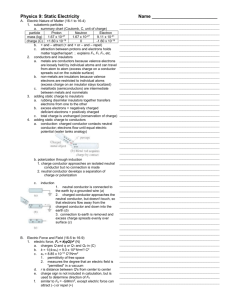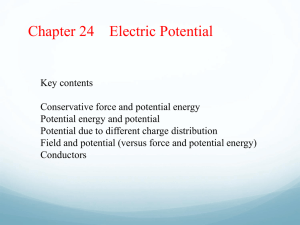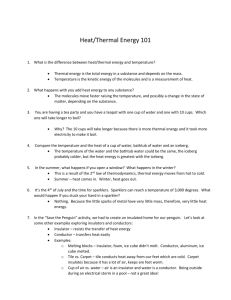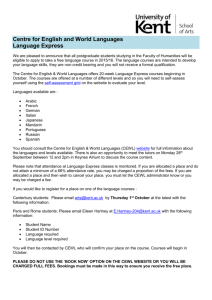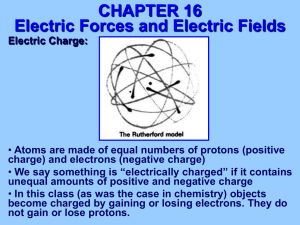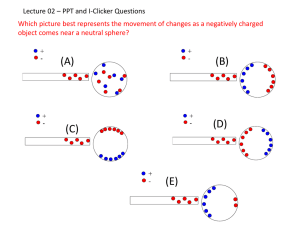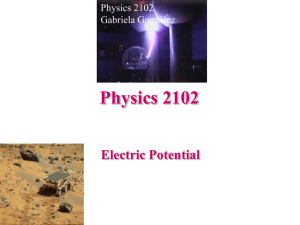Stat_Elec_and_Mag_Un..
advertisement
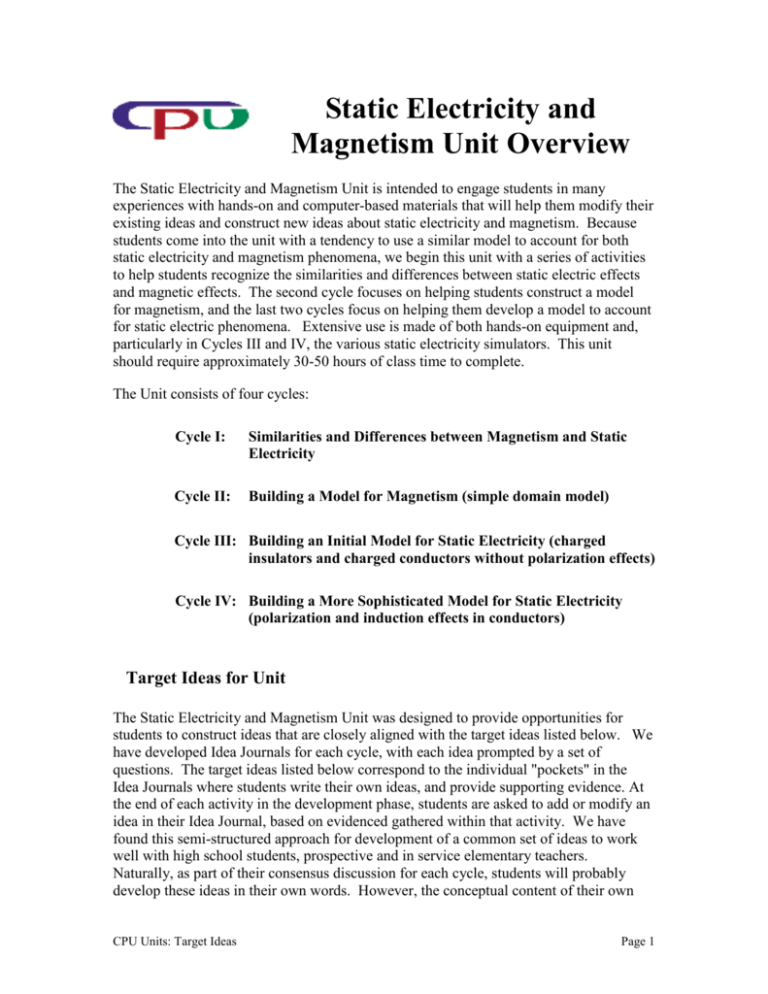
Static Electricity and Magnetism Unit Overview The Static Electricity and Magnetism Unit is intended to engage students in many experiences with hands-on and computer-based materials that will help them modify their existing ideas and construct new ideas about static electricity and magnetism. Because students come into the unit with a tendency to use a similar model to account for both static electricity and magnetism phenomena, we begin this unit with a series of activities to help students recognize the similarities and differences between static electric effects and magnetic effects. The second cycle focuses on helping students construct a model for magnetism, and the last two cycles focus on helping them develop a model to account for static electric phenomena. Extensive use is made of both hands-on equipment and, particularly in Cycles III and IV, the various static electricity simulators. This unit should require approximately 30-50 hours of class time to complete. The Unit consists of four cycles: Cycle I: Similarities and Differences between Magnetism and Static Electricity Cycle II: Building a Model for Magnetism (simple domain model) Cycle III: Building an Initial Model for Static Electricity (charged insulators and charged conductors without polarization effects) Cycle IV: Building a More Sophisticated Model for Static Electricity (polarization and induction effects in conductors) Target Ideas for Unit The Static Electricity and Magnetism Unit was designed to provide opportunities for students to construct ideas that are closely aligned with the target ideas listed below. We have developed Idea Journals for each cycle, with each idea prompted by a set of questions. The target ideas listed below correspond to the individual "pockets" in the Idea Journals where students write their own ideas, and provide supporting evidence. At the end of each activity in the development phase, students are asked to add or modify an idea in their Idea Journal, based on evidenced gathered within that activity. We have found this semi-structured approach for development of a common set of ideas to work well with high school students, prospective and in service elementary teachers. Naturally, as part of their consensus discussion for each cycle, students will probably develop these ideas in their own words. However, the conceptual content of their own CPU Units: Target Ideas Page 1 ideas should be similar to these. In a latter section we include samples of the ideas actually constructed by the students themselves. The Teacher Guide for each cycle provides examples of the kinds of statements students actually develop in the class. After the class agrees on a set of ideas the teacher should introduce appropriate terminology and conventions so that the students' are more closely aligned with the corresponding ideas they would find in textbooks or when they talk with other students. Since part of this unit is devoted to helping students differentiate between magnetic and electrostatic phenomena, we introduce a couple of terms. An M-object is an object that will interact with a magnet and one will observe attraction or repulsion. M-objects can be rubbed or unrubbed. An E-object will interact with a wool-rubbed straw and one will observe either attraction or repulsion. . E-objects can be rubbed or unrubbed. Target Ideas for Cycle I 1. E and M Materials Idea: M-objects have iron in them. E-objects can be made of (almost) any material. 2. Producing E and M Objects idea: To produce a rubbed M-object, you rub it with a magnet in one direction only. To produce a rubbed E-object you can rub it with wool (or perhaps some other material) in any direction 3. Rubbed and Unrubbed Objects Interaction Idea: A rubbed E (M) object always attracts an unrubbed E (M) object. A rubbed E (M) object either attracts or repels another rubbed E (M) object. 4. E-objects are one-ended idea: A rubbed E-object has the same type of interaction (attraction or repulsion) with all parts of another rubbed E-object. (Thus, all parts of a rubbed E-object seem to exhibit the same properties.) 5. M-objects are two-ended idea: A rubbed M-object has an opposite type of interaction (attraction or repulsion) with the two ends of another rubbed M-object. (Thus, opposite ends of a rubbed M-object seem to exhibit opposite properties.) 6. Retention of properties and Influence of Water idea: M-objects tend to retain their magnetic properties for a long period of time. Water does not seem to effect magnetic effects. E-objects loose their properties readily. Water tends to eliminate or reduce static electric effects. 7. E and M Object Influence with Distance idea: The strength of an electric or magnetic effect decreases with distance from the E or M object. CPU Units: Target Ideas Page 2 Target Ideas for Cycle II 1. Fundamental magnetic entities idea: A ferromagnetic material contains fundamental entities, each of which behaves like a tiny magnet (two-endedness). Each tiny magnet can be oriented in any direction. 2. Magnetic strength idea: The magnetic strength of a ferromagnetic object depends on the number and relative alignment (or orientation) of the fundamental magnetic entities inside the object. The relative alignment of the entities can be changed when another magnet is held nearby, touches, or rubs in one direction the ferromagnetic material. In an unmagnetized object the fundamental entities are randomly oriented; that is, there is no preferred orientation. In a partially magnetized object there is a partial alignment of the fundamental entities; the greater the alignment the greater the magnetic strength. In a fully magnetized object the fundamental entities are aligned in a single direction. For the same relative alignment, the greater the number of fundamental magnetic entities inside an object, the greater its magnetic strength; thus, larger magnetized objects can have greater magnetic strength than smaller magnetized objects. Figure 1. Two possible diagrams of the target model 3. Size of M objects idea: For similarly rubbed M objects, the larger the object the greater it's magnetic strength. 4. Combining magnets idea: Magnets combined with their poles aligned in the same direction enhance each other's magnetic strength; magnets combined with CPU Units: Target Ideas Page 3 their poles aligned in opposite directions will diminish each other's magnetic strength. Target Ideas for Cycle III 1. Electrical insulators and conductors idea: Electrical conductors can transfer effects from one end to the other; insulators cannot. If one end of a conductor is rubbed with a charged object, the entire conductor is affected. If one end of an insulator is rubbed with a charged object, only that part is affected; the rest of the insulator is not affected. 2. Charging an insulator by rubbing idea: When two different insulators are rubbed together, blue charge from one insulator is transferred to the other. As a result, one object is left with an excess of blue charge (or negative charges) and the other is left with a deficit of negatives (or excess of positive charges). The greater the amount of rubbing, the greater the amount of excess charge on the surfaces and this can be represented macroscopically by thicker or thinner red and blue lines. The type of excess charge that accumulates on each surface depends on the properties of the two rubbed insulators. Some insulators tend to acquire negative charge more easily than others and some insulators tend to give up negative charges more easily than others. 3. Location of excess charge idea: Excess electrical charge is located on the rubbed surface of charged objects. 4. Losing charge by touching idea: If you touch a charged insulator, it can lose its excess charge at the point of contact only; hence you need to touch a charged insulator all over the rubbed surface to remove all its excess charge. If you touch a charged conductor anywhere, it loses all its excess charge. 5. Direction of electric force idea: Objects with opposite types of excess electric charge will attract each other; objects with the same type of excess electric charge will repel each other. The greater the amount of excess electric charge, the greater the strength of the electrical force. 6. Amount and strength of excess charge with rubbing idea: When two neutral insulators are rubbed together, the amount of excess charge accumulated on the surface of one object is equal in amount, but opposite in type, to the excess charge appearing on the surface of the other object. The greater the amount of rubbing the greater the amount of excess charge that is produced (up to a limit). The greater the amount of excess charge on the surfaces of two objects, the greater the strength of the electrical force between them. 7. Charging a conductor by rubbing idea: When a conductor is rubbed with a charged object, some of the excess charge on the object is transferred to the CPU Units: Target Ideas Page 4 conductor, and the conductor acquires the same type of excess charge as the object. 8. Microscopic entities idea: There are two types of entities involved in static electricity. By convention, we can refer to these as positive charge and negative charge. Objects that have an excess of negative charges are negatively charged. We can represent this macroscopically by coloring the negatively charged surface blue. Objects that have an excess of positive charges (or lack of negative charges) are positively charged. We can represent this condition macroscopically by coloring the positively charged surface red. Objects that have equal amounts of positive and negative charges are said to be neutral. We can represent this condition by coloring the objects light purple. Target Ideas for Cycle IV 1. Neutral conductor idea: A neutral or uncharged conductor has an equal amount of both types of charge. A charged conductor has more of one type of charge than the other. If a conductor has more negative charges than positive charges then it negatively charged. If it has more positive charges than negative charges (of deficit of negative charge), then it is positively charged. 2. Charge separation in a conductor idea: When a charged object is brought near a neutral or charged conductor, negative charges within the conductor move toward (if the external object is positively charged) or away from (if the external object is negatively charged) the external charged object. If the external charged object is negatively charged, then negative charges within the conductor are repelled as far away from the external object as possible leaving the end of the conductor nearest the object positively charged and the far end of the conductor negatively charged. Thus, charges are separated (or polarized) within a neutral conductor. 3. Transfer of charge between conductors idea: If two conductors are in contact, electric charge may move from one conductor to the other. 4. Grounding idea: The human body is a conductor of electric charge. When a person touches a charged conductor, sufficient charge is transferred between the person and conductor to neutralize the conductor. This process is called "grounding." 5. Charging by grounding idea: When a charged object is held near a neutral conductor, and the conductor is grounded (touched by a person), sufficient charge is transferred between the person and the conductor. If we assume that only negative charges are mobile, then conductor either loses charge to the person (if the object is negatively charged) or gains charge from the person (if the object is CPU Units: Target Ideas Page 5 positively charged). The conductor then retains either an excess of positive or negative charges. This process is also referred to as "charging by induction." CPU Units: Target Ideas Page 6

